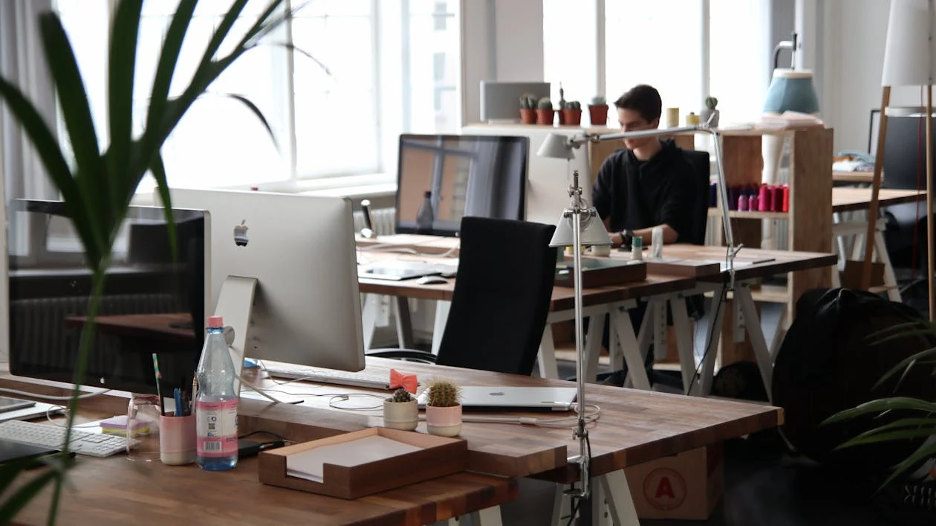
Design of Office: Crafting Productive and Efficient Workspaces
The design of office spaces plays a crucial role in shaping workplace efficiency and employee productivity.
At MatchOffice, we understand that optimizing office layout isn't just about aesthetics—it's about creating environments that foster collaboration, innovation, and growth.
What is an Office Layout
An office layout encompasses the strategic placement of furniture, equipment, and overall space configuration within an office setting.
This layout is not merely about aesthetics but serves as a fundamental framework that influences various crucial aspects of a workplace.
- Company Culture: The design of an office reflects company values and culture. Open spaces might suggest transparency and collaboration, whereas private offices can denote a preference for autonomy and confidentiality. The physical environment sets the tone for interpersonal relationships and the general atmosphere within the company.
- Communication Flow: How an office is laid out can significantly affect how information flows between teams. For example, an open-plan office facilitates immediate and spontaneous communication, while a segmented layout might require more formalized channels of communication.
- Efficiency and Productivity: Efficient office layouts minimize wasteful movement and unproductive activities. By designing workspaces with the tasks in mind, companies can streamline operations and reduce the time employees spend moving between spaces. This includes placing frequently used equipment like printers or copiers in central locations and designing workflow-based layouts that match the process sequences of different teams.
- Employee Well-Being and Comfort: An office layout that considers ergonomics, natural lighting, sound acoustics, and personal space can greatly enhance employee comfort and well-being. In comfort, employees are not only happier, but are also more productive and less likely to incur workplace-related health issues.
- Privacy and Noise Reduction: In any office environment, managing noise can significantly impact productivity. Strategic placement of noise-absorbing materials, office plants, and modular walls can help reduce the distraction of overheard conversations and operational noise. Similarly, providing areas for confidential discussions or focused work without resorting to completely isolated environments can balance openness with the need for privacy.
- Health and Safety: A well-thought-out office layout promotes safety by ensuring clear pathways for evacuation in emergencies and minimizing hazards related to overcrowding or poorly placed furniture and equipment. Good layouts also address health considerations, such as the potential for strain from poor lighting or improperly configured workstations.
How to Design Office Space
Before you begin to sketch out your plans or purchase new furniture, consider these foundational aspects with the help of commercial rental agents:
- Size of the Space: Understanding the physical dimensions of your office is crucial. It determines how much you can feasibly do within the available area without causing clutter or inefficiency.
- Type of Work Performed: The nature of your employees' tasks will dictate much of the layout. Creative professionals might need open spaces for brainstorming, whereas tasks requiring high concentration might benefit from private office layout ideas.
- Number of Employees: More employees generally require more space, but efficiency in using that space is key. Multiple desk office layouts need to be designed to prevent crowding while ensuring accessibility.
- Budget: Financial constraints can significantly affect your options. It’s important to prioritize where to spend and where to save, possibly considering phases for your office design.
- Locale: Your office's location impacts several design elements, including the availability of natural light, external views, and even local compliance regulations concerning office layouts.
Office Planning Types

Choosing the right office layout is essential for fostering a productive work environment.
Different layouts serve different organizational needs and can significantly impact employee interaction, privacy, and efficiency.
At MatchOffice, we help you navigate the different types of office spaces to identify the one that best suits your business goals and work culture.
Open Plan
The open-plan layout is characterized by its lack of interior design and private offices, which creates a vast, unobstructed space that helps you learn how to lease commercial property.
This design promotes an environment of transparency and easy communication, making it easier for teams to collaborate spontaneously and for information to flow freely throughout the space.
While the open plan is conducive to teamwork and a communal work atmosphere, it can also lead to higher noise levels and more distractions, which might reduce individual productivity.
To mitigate this, strategic placement of soft furnishings, plants, and acoustic panels can be utilized to absorb sound and create informal division.
Cubicle Setup
Cubicles have been a staple in office design for decades. They offer a personal workspace delineated by partitions from other workstations.
This setup provides a sense of individual space while maintaining the accessibility of an open plan.
Cubicles are versatile and can be arranged in typical office configurations to maximize office space and encourage a sense of community amongst employees.
However, this layout can sometimes be viewed as repetitive and uninspiring.
Incorporating ergonomic furniture, personal storage solutions, and adjustable lighting can enhance the cubicle set up and personalize the workspace.
Hybrid Layout
Hybrid layouts represent a blend of open and private office spaces, integrating the best elements of both designs.
This modern approach to office layout provides employees with the flexibility to choose their work setting based on the task at hand.
For instance, open areas can be utilized for collaborative projects and brainstorming sessions, while private pods or quiet zones can be available for tasks requiring high concentration or confidentiality.
Hybrid layouts cater to diverse working styles and needs, making them ideal for companies that value both collaboration and individual work.
Co-working Spaces
Co-working spaces are designed to support a mixture of individuals and small teams, typically freelancers, remote workers, and startups.
These environments encourage networking and collaboration through shared work areas and common resources like meeting rooms, kitchens, and lounges.
Co-working spaces are cost-effective office layout solutions for small businesses and entrepreneurs. They offer the flexibility of short-term lease types and opportunities for community engagement.
The dynamic nature of co-working spaces can lead to increased creativity and opportunities for professional connections.
Private Offices
Private offices are designated spaces that offer solitude and are shielded from the general hustle and bustle of the workplace.
Ideal for positions that require a lot of focus or handle sensitive information, these offices help minimize distractions and maximize productivity.
Although private offices can isolate employees from one another, they are valuable in layouts where confidentiality and undisturbed work are priorities.
Integrating private offices within a more open or hybrid layout can provide an optimal office layout, allowing for both secluded work and team interaction.
Ideas for Office Layout
Integrating strategic layout planning can dramatically enhance both functionality and employee satisfaction when crafting the design of office spaces.
MatchOffice suggests several effective offices planning layout strategies to optimize your workspace.
Here are detailed approaches using the provided keywords, formatted with bullet points for clarity and emphasis:
Optimal Furniture Placement
- Maximize Natural Light: Arrange desks and seating to maximize incoming natural light, which can boost mood and productivity.
- Reduce Glare: Position computer screens such that they face away from direct sunlight to reduce glare, which can lead to eye strain and discomfort.
- Facilitate Communication and Movement: Implement office desk layouts that encourage easy flow of communication and physical movement. Desks should be positioned to encourage interaction without causing congestion.
- Efficient Use of Space: Ensure that the arrangement of furniture does not obstruct pathways, but instead complements the natural flow of the workspace.
Zoning for Different Activities
- Meeting Zones: Establish well-equipped areas for group discussions and client meetings, potentially utilizing modular furniture for flexibility.
- Relaxation Areas: Designate zones for relaxation and informal gatherings. These zones can include comfortable seating and ambient elements such as plants or artwork.
- Focused Work Areas: Create zones that minimize noise and disruptions, suitable for tasks requiring deep concentration. Acoustic treatments and visual privacy solutions could benefit these zones.
- Collaboration Spaces: Incorporate areas designed for dynamic interaction, equipped with technology and adaptable furniture for team-based work.
Adaptability and Flexibility
- Modular Furniture: Choose furniture that can be easily moved or reconfigured to suit various needs and events, such as foldable chairs, tables, or desks on casters.
- Adjustable Features: Invest in desks and chairs that are adjustable to accommodate different body types and working styles, enhancing ergonomic comfort.
- Technology Integration: Ensure that the office can adapt to new technologies. Include features like built-in power outlets in tables and accessible data ports throughout the office.
- Scalable Design: Plan layouts that can be easily scaled or modified as the team grows or changes, ensuring long-term usability of the space.
Modern Trends in Office Layout

Choosing the right office layout is essential for fostering a productive work environment.
Staying updated with the latest trends is crucial for creating an environment that is not only efficient but also inviting and forward-thinking.
MatchOffice highlights several modern trends that can transform traditional office layouts into spaces that are innovative, sustainable, and inclusive.
Below are detailed insights into these trends, structured with bullet points for better readability:
Biophilic Design
- Natural Materials: Use wood, stone, and bamboo within the office décor to bring the outside in, creating a warmer, more welcoming environment.
- Water Features: Incorporate elements such as small fountains or aquariums to enhance the aesthetic appeal and provide a calming effect.
- Plant Life: Integrate a variety of plants throughout the office to purify the air and add visual interest. Consider living green walls for dramatic impact and improved air quality.
- Natural Lighting: Design an office building to maximize the amount of natural light, which not only saves energy but also has been shown to improve employee mood and productivity.
Technology Integration
- Smart Lighting Systems: Install lighting systems that automatically adjust based on the time of day and available natural light, enhancing comfort while reducing energy use.
- Advanced HVAC Systems: Utilize smart thermostats and HVAC systems that learn from occupancy and usage patterns to optimize temperature and air quality.
- Automated Workstations: Equip workstations with technology that adjusts to the user’s preferences for desk height and monitor position, promoting better posture and ergonomics.
- High-Tech Communication Tools: Implement state-of-the-art conferencing technologies and seamless connectivity options to support remote and hybrid work models.
Fostering Inclusivity
- Universal Design: Create spaces that are accessible to all employees, including those with disabilities, ensuring that doorways, passageways, and common areas meet accessibility standards.
- Flexible Workspaces: Offer a variety of work areas that cater to different work styles and needs, allowing employees to choose how and where they work best.
- Adjustable Furniture: Provide furniture that can be customized for different body types and physical requirements, including adjustable desks and chairs with proper ergonomic support.
Green Zones and Energy Saving
- Eco-Friendly Materials: Use recycled and sustainable materials for furniture and finishes, reducing the environmental footprint to list your office space
- Energy-Efficient Appliances: Opt for appliances and equipment that are Energy Star-rated to minimize energy consumption.
- Solar Energy: Consider the installation of solar panels to supplement your energy needs, reducing reliance on non-renewable power sources and decreasing operational costs.
Conclusion
Designing a separate office space that aligns with your workforce's needs is crucial for enhancing productivity and satisfaction.
At MatchOffice, we believe in creating office environments that meet and exceed the functional requirements of the modern office.
By incorporating these ideas and staying updated with current trends, you can ensure that your office layout truly reflects your organization's values and objectives.




